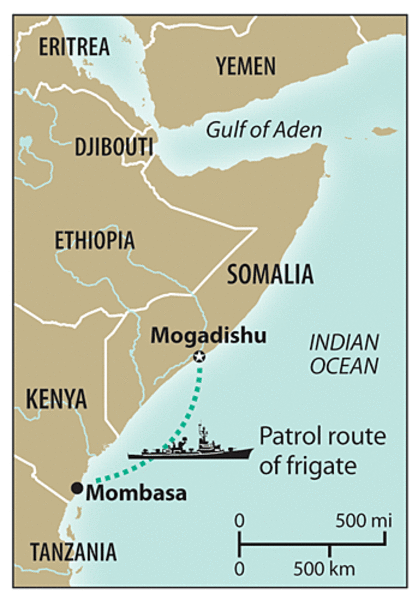Getting food ships past Somalian pirates
Loading...
| HMCS Ville de Québec, NEAR SOMALIA
On the bridge of the HMCS Ville de Québec, Cmdr. Chris Dickinson keeps a watchful eye on his charge.
For two days, the tall, blond Canadian commander has escorted a rusty cargo ship through the most dangerous, pirate-infested waters in the world.
As the MV Golina, filled with food for Somalia's poor, approaches the port city of Mogadishu, he remains alert. The Canadian naval frigate gently rocks two miles off the coast. His crew scans for fast-moving skiffs that could launch a suicide attack; the ships' guns are armed and ready.
Until last month, Commander Dickinson's 47,000-ton frigate was stationed in the Mediterranean. His crew is trained to hunt subs. But at the request of the United Nation's World Food Program (WFP), his assignment now is to keep the pirates at bay. He shadows cargo ships full of grain and other supplies as they make the 510-mile journey from the Kenyan port of Mombasa to Somalia.
The WFP is trying to feed more than 3 million people at risk of starvation. Deliveries over land can bring only a fraction of the food needed, and are even more prone to attacks and hijacking.
Three cargo ships contracted by the WFP were snatched by pirates before the international escort service began a year ago. France, Denmark, and the Netherlands have sent warships for short periods to protect the shipments. But there are invariably gaps in the protection as each nation takes up the role, shutting down the vital food pipeline for weeks at a time.
Make my day?
Dickinson says he's there as a deterrent, making sure the pirates know that they will be biting off more than they could chew if they try to board a WFP cargo ship.
Armed with heavy machine guns and assault rifles, his crew is under orders to open fire on anything that comes within 500 yards. In the open sea, the ship's helicopter circles overhead, watching for boats moving too fast to be fishermen.
But his job isn't to seek out and destroy pirates. In fact, on the way to this assignment, he had to ignore his radar when, as he sailed through the Gulf of Aden, it began picking up the locations of recently hijacked ships.
"What we don't want is dead hostages," he says. "There are negotiations under way with the owners of those vessels and we don't have the specialized personnel we would need so any intervention would be counterproductive."
At least 55 vessels have been attacked or hijacked by Somali pirates this year. Insurance premiums have skyrocketed. It now costs $9,000 to send cargo through the Gulf of Aden, up from $900 a year ago.
Almost two decades after the 1991 collapse of Somalia's last functioning government, the lawlessness and fighting among Somali warlords has now spread to the waters off the coast. Criminal gangs, armed with AK-47s and rocket-propelled grenades, now patrol the sea. By some estimates, there are nearly 1,000 pirates plundering ships in the area.
A US-led naval antiterrorism task force has been given responsibility for trying to keep the international sea lanes open. They have established what should be a safe corridor through the Gulf of Aden, which is patrolled by warships and coalition aircraft overhead.
But the task force is charged with patrolling a vast area of ocean where the tiny skiffs disappear between the waves.
And the attacks continue. By some estimates, the ransom payments or sale of the cargo are earning the gangs as much as $1.5 million per ship.
Pottengal Mukundan, director of the International Maritime Bureau, says the frequency of attacks is unprecedented.
"We would like to see naval vessels homing in on the [pirates'] mother ships that are operating in the Gulf of Aden, getting on board and confiscating weapons that they have and disrupting their operations. If that can be done it will frustrate their actions," he says by telephone from London.
Tackling the pirates head-on has met with some success.
French commandos have twice launched raids on ships held by pirates. Last week, a special forces team freed the 50-foot Carre d'As yacht and her crew, a retired couple who had been sailing from Australia to France when they were snatched by pirates at the beginning of September.
But there have been setbacks.
Earlier this month, a Danish naval vessel detained 10 suspected pirates, who were heavily armed and traveling in two speedboats.
This week, it was reported that the suspects had been released because they could not be tried under Danish law, as they had not committed an offense.
Mission accomplished
Further south, back on the Canadian frigate, Dickinson's crew carefully watches the Golina lumber closer to the Somali port of Mogadishu.
As his charge arrives, Dickinson's mission is accomplished. He orders a new course set – back to Mombasa, Kenya, where another aid ship will be waiting.
"To see the ship go into Mogadishu to start to unload, and knowing the food is going inland to people who need it, that is a fantastic feeling," he says.






